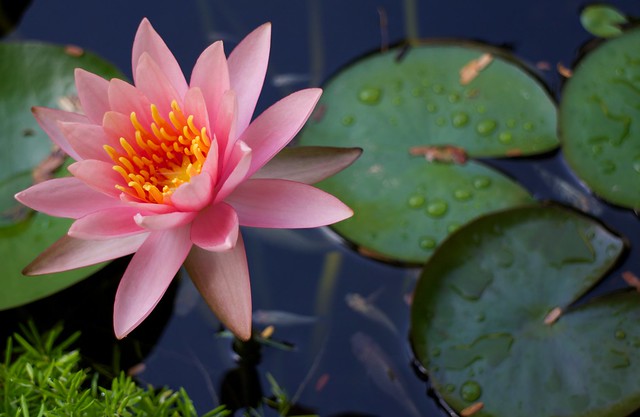September 2013
At least three published reviews have
declared glyphosate (active ingredient of Monsanto's 'Roundup') to be
an ideal herbicide due to its specificity and acclaimed low toxicity
to non-target organisms in the environment.
 |
| Water lily. CC Photo by Mahmood Al-Yousif on Flickr |
Indeed, a majority of short-term
studies on the aquatic invertebrate, Daphnia magna,
a commonly accepted model animal in environmental toxicity studies,
has pronounced 'glyphosate' to have 'no adverse effect', to be
'non-toxic' or 'moderately toxic', or to have 'low toxicity'.
However,
experiments over the decades since glyphosate was first marketed have
demonstrated an unexplained variability in toxicity across several
orders of magnitude.
Glyphosate is
heavily used in agriculture, forestry, gardening and waterway
management, from where it seeps into ground-water and drinking water.
With the advent of 'Roundup Ready' GM monocultures, quickly
followed by Roundup-resistant super-weeds, the quantity of glyphosate
entering the ecosystem has increased exponentially.
In light of this,
the scientific uncertainty attaching to experimental results which
have proven unrepeatable as described above, is of concern,
especially to ecologists.
Suspecting that
there must be some uncontrolled variables in the glypohosate toxicity
experiments which were affecting the outcomes, a Norwegian team of
scientists investigated the cause of the discrepancies.
Their
findings eliminated the possibility that the use of different clones
of Daphnia magna could
be causing the variations, but they did
unearth some fundamental weaknesses in the materials and methods of
previous studies.
One of these was the indiscriminate use of the common name
'glyphosate' to describe the substance being tested.
'Glyphosate' can exist in a number of chemical forms which have
different solubilities in water, and 'glyphosate' formulated into
different versions of 'Roundup' can have a variety of different
adjuvants added. Solubility and adjuvants both have a profound
effect on glyphosate penetration into cells, and therefore on its
toxicity. Other experimental conditions, such as acidity, buffering
and temperature, are also important in rendering glyphosate more, or
less, toxic.
The
concentration of active
glyphosate tested will also change depending on the actual format
used. For example, one study in the 1980s expressed the
concentration of the harmful dose of Roundup in terms of its whole
formulation including
the
water content.
The second weakness has been the use of 'death' as the only
significant end-point for toxicity studies.
What
the Norwegian scientists recorded were glyphosate and Roundup effects
on a full range of life-history traits i.e. survival, growth,
fecundity, abortion rates, juvenile body size and age-effects. They
found adverse signs in all
these parameters at a glyphosate concentration around the US and
Canadian environmental guideline contamination maximum, including
“complete reproductive failure” and signs of increased
sensitivity in younger Daphnia.
Actual readings of glyphosate contamination in streams draining
Roundup Ready soya fields in Argentina found levels of up to ten
times these environmental guidelines.
The
European Commission working document on glyphosate (EZ2002), which
forms the basis for European regulation in the context of health and
the environment, uses toxicity values obtained in 1981. These are
clearly derived from a form of glyphosate which has low
water-solubility, and therefore low toxicity. Measurements of these
effects on Daphnia
were then extrapolated into a general value for acute toxicity of
glyphosate in all
aquatic invertebrates. Thus glyphosate became officially “harmless”.
In summary, the authors conclude that according to their experimental
work plus literature reviews, the published toxic levels for
glyphosate are not representative. They continue “The
classification of glyphosate as “practically non-toxic to aquatic
invertebrates is based on these non-representative values”.
It seems the low toxicity myth has proved tenacious, being
extensively referred to in the literature and finding its way into
regulatory documents.
As the Norwegian scientists politely suggest, the safety
classification of glyphosate “needs to be adjusted”.
OUR COMMENT
Sadly, this story is one of decades of bad science: the material in experiments was not specified and not comparable, the observed variation was either ignored or used as a basis for cherry-picking which results to accept, and an entirely unjustifiable extrapolation was made from a single animal to the whole of its ecosystem.
The most shocking thing is how long it has taken, and how many regulatory bodies have looked at the studies, before anyone noticed anything amiss.
Damage to aquatic life is just another way in which glyphosate is wrecking the environment.
SOURCE:
- Marek Cuhra et al., 2013, Clone- and age-dependent toxicity of a glyphosate commercial formulation and its active ingredient in Daphnia magna, Ecotoxicology 22
No comments:
Post a Comment
Thanks for your comment. All comments are moderated before they are published.